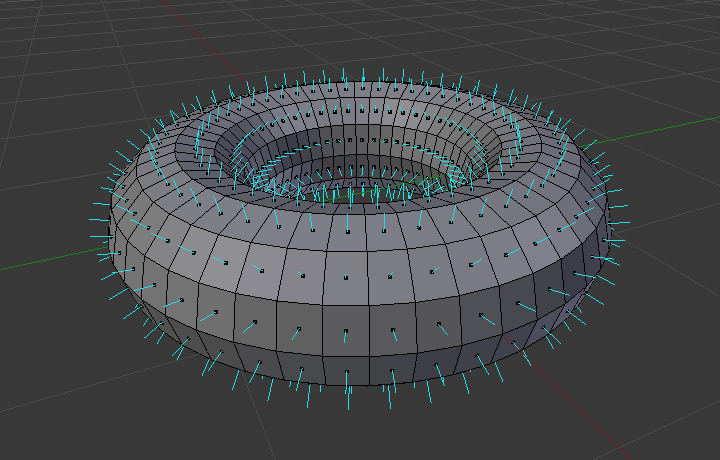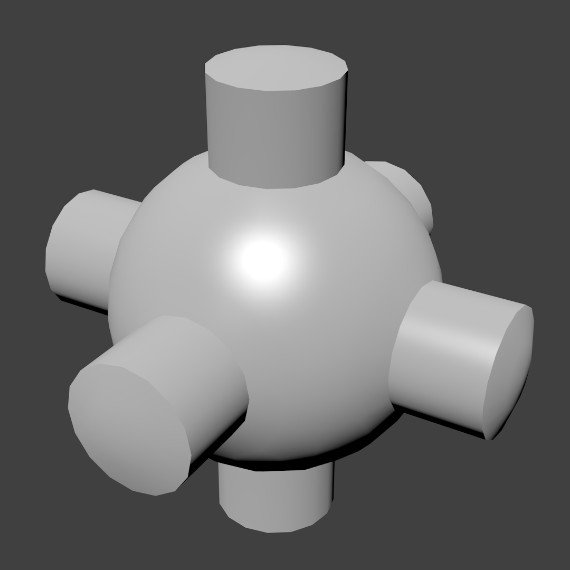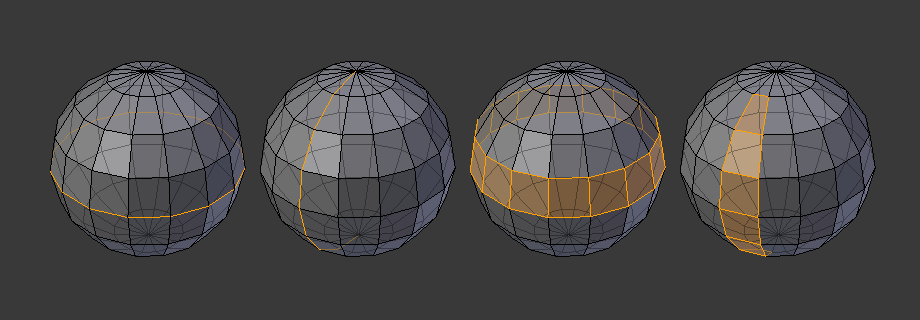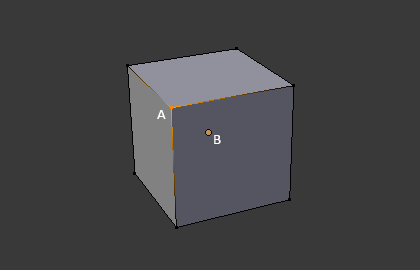结构¶
对于一切网格,都是由三个基本结构构成的: 顶点 *, 边* 和 面。
网格结构示例。¶
顶点(复数)¶
The most elementary part of a mesh is the vertex (vertices plural) which is a single point or position in 3D space. Vertices are represented in the 3D Viewport in Edit Mode as small dots. The vertices of and object are stored as an array of coordinates.
边¶
边是连接两个顶点之间的直线。当你在线框视图着色方式下查看网格时边是 "线" 。这些线条通常不会出现在渲染图像上。它们用于构造面。
面¶
Faces are used to build the actual surface of the object. They are what you see when you render the mesh. If this area does not contain a face, it will simply be transparent or non-existent in the rendered image.
三个(三角面),四个(四边面)或更多(n边面)顶点之间的区域定义为面,每侧都有一条边,通常缩写为 tris,quads & n-gons。
三角形总是平坦的,因此易于计算。另一方面,四边形 "利于形变" ,因此常用于动画和细分建模。
See also
法向¶
在几何中,法向是指垂直于某种元素(通常是一个三角面或一个曲面) 的方向或直线,但也可以是相对于一条直线、曲线上一点的切线或曲面上一点的相切面。

显示环体面法向。¶
在上图中,每条蓝线表示环体上一个面的法向。每条线都垂直于其所在的面。法向显示可以在编辑模式开启,在 视图覆盖面板网格显示视图。
属性¶
参考
- 面板

法向面板。¶
- 自动光滑
当设置网格的这些部分的着色方式为平滑,相邻面之间的夹角小于指定 角度 值时,公共边将被平滑。这是一种更加简单的平滑和锐边结合使用的方式。

开启了 自动平滑 的示例网格。¶
自定义拆边法向¶
自定义拆边法向 是一种通过使法向指向默认法向和自动计算法向以外的方向来进行微调和假着色的方式。该方式主要用于游戏开发,可以抵消一部分低多边形物体所带来的问题(最常见的例子就是低多边形树、灌木、草等。以及一些圆形的角落)。
Blender支持在 '光滑扇形` 上自定义法线,其被定义为一组共享相同顶点的相邻面并彼此以 '光滑边` 进行连接。这意味着您可以单独定义某组面拐角的法向、某部分相邻面片的法向或某顶点。
导入自定义拆边法向数据¶
某些工具,特别是 CAD 这类工具,常常会在转换为网格时生成不规则几何结构(非常薄或非常长的三角形等。)。自动计算得到的法线在这类几何体上的效果常常不太好,因此能够导入和使用CAD工具自己生成的法向数据就显得尤为重要。
Note
当前,只有 FBX Importer 和 Alembic Importer 可用于导入自定义法向。
拓扑¶
循环¶

边和面循环。¶
边 和 面循环 是形成连续 "循环" 的一组面或边,如上图 边和面循环。 所示。
In the image above, loops that do not end in poles are cyclic (1 and 3). They start and end at the same vertex and divide the model into two partitions. Loops can be a quick and powerful tool to work with specific, continuous regions of a mesh and are a prerequisite for organic character animation. For a detailed description of how to work with loops in Blender, see: Edge Loop Selection.
Note
请注意,循环(2和4)不能围绕整个模型。循环在所谓的极点上中断,因为没有从极点继续循环的路径。极点是连接到三个,五个或更多边的顶点。因此,与一条,两条或四条边连接的顶点不是极点。
边缘循环
图 边和面循环。 中1和2为边循环。循环边上的顶点需满足:每个顶点正好有两个不在循环中,且分别位于循环两侧的相邻顶点(极点情形下的首尾端点例外)。
边循环是一个重要的概念,特别是在生物(细分)建模和角色动画中。正确使用的话,可以使用相对少的顶点构造模型,使其用在细分表面和变形动画时,看起来非常自然。
Take Fig. 边和面循环。 in organic modeling as an example: the edge loops follow the natural contours and deformation lines of the skin and the underlying muscles and are more dense in areas that deform more when the character moves, for example at the shoulders or knees.
Further details on working with edge loops can be found in Edge Loop Selection.
面循环
这些是边循环的逻辑延伸,它们由两个边循环之间的面组成,如图 边和面循环。 中的循环(3和4)所示。请注意,对于非闭合循环(4),包含极点的面不包括在面循环中。
有关使用面循环的更多详细信息,请参考 面循环选择。
